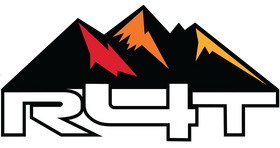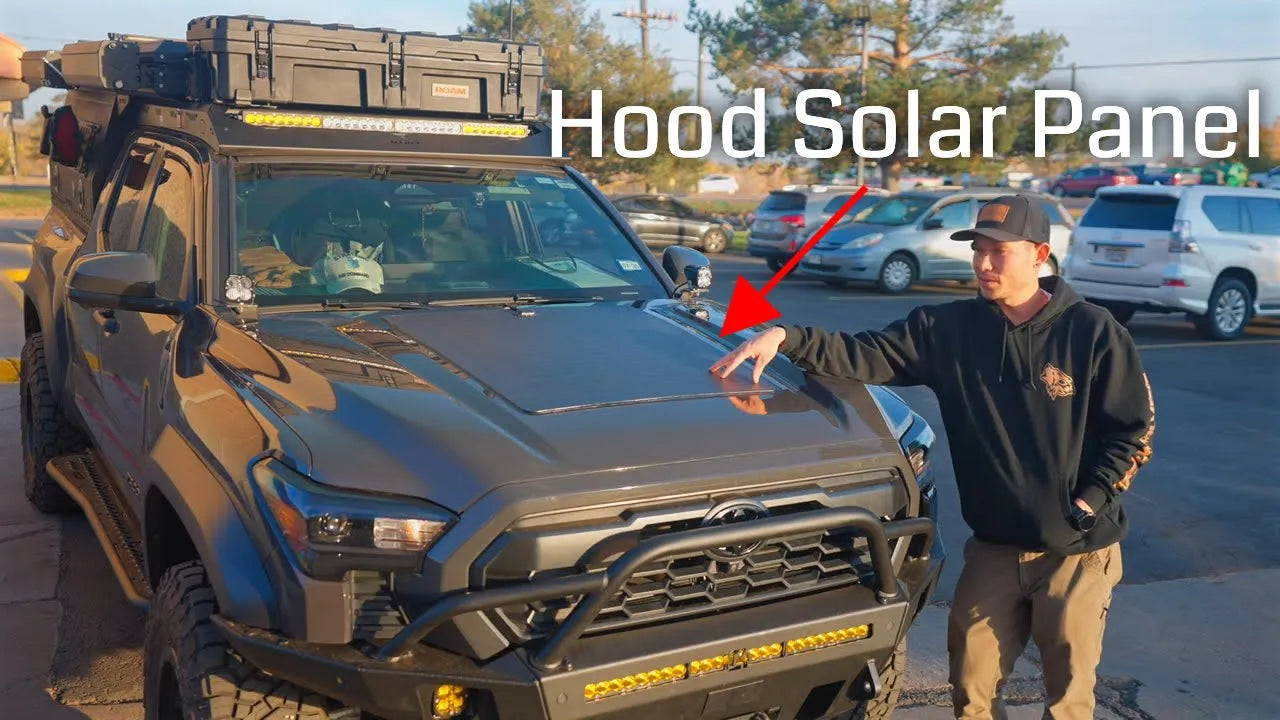The Problem: Modern Trucks, Sleepy Batteries
Today’s trucks—especially 2024+ Toyota Tacoma and 2022+ Toyota Tundra—run a lot of electronics in the background. ECUs check systems, cameras, and sensors stay on standby, and accessories (radios, fridges, dash cams) add a quiet but steady load. Leave your truck parked at camp, at work, or in the driveway for a few days, and you can return to a sluggish or dead starter battery.
If you’re planning to get into overlanding, a battery hiccup is more than an inconvenience—it can strand you far from help and cut a trip short.
The Solution: Hood-Mounted Solar + MPPT
A hood solar panel (we commonly install the Lensun 100W Hood Solar Panel) paired with an MPPT controller trickle-charges your starter battery whenever there’s daylight. It’s “set it and forget it” maintenance charging that:
-
Keep your starter battery near a full state of charge
-
Offsets parasitic draw from modern electronics
-
Improves battery health and lifespan by avoiding deep discharges
-
Works even while you’re away from the truck for days
An MPPT controller maximizes the panel’s energy harvest and regulates charging safely. Many systems also offer Bluetooth app monitoring so you can check voltage, current, and daily yield right on your phone.
Why Hood Solar Is Ideal for Overlanding
1) Always Charging, Even When Parked
Overlanding involves a lot of parked time—camp setups, photo ops, fishing, or just enjoying camp. Hood solar keeps the starter battery topped while you relax, so the engine fires up confidently when it’s time to move.
2) Low-Profile & Trail-Friendly
A hood panel sits flush and doesn’t snag branches. There’s no setup, teardown, or storage like portable panels. You’ll actually use it every day, which is the whole point.
3) Protects the “Brain” of Your Build
Your starter battery is the gateway to everything. If it’s weak, nothing else matters. Keeping it healthy also protects winches, lighting, compressors, radios, and fridges from low-voltage headaches.
4) Extends Battery Life
Lead-acid batteries last longer when they spend most of their life at a high state of charge. Consistent solar maintenance dramatically reduces sulfation and premature failure.
5) Works With Dual-Battery & Power Stations
Use the MPPT’s LOAD terminals or a DC-DC system to feed a secondary battery while prioritizing the starter. You can scale later without replacing the hood panel.
Realistic Output: What to Expect from a 100W Panel
-
Peak sun typically yields 60–80W in real life (angle, heat, and shading matter).
-
That’s plenty for offsetting parasitic loads and maintaining a healthy state of charge.
-
Even on cloudy days, a few watts of trickle helps—every bit slows the discharge curve.
Installation Overview (What We Recommend)
-
Vinyl Underlay (Optional but Recommended):
Creates a clean substrate, adds UV protection, and makes future removal easier. -
Adhesion:
Use quality automotive double-sided tape around the perimeter and along vertical ribs of the panel. Apply even pressure; sandbags work great for hood contours. -
Wiring & Protection:
Route cables cleanly, add a fuse near the battery, and protect wires from heat and abrasion. -
MPPT Controller Placement:
Mount it in a dry, accessible location. Pair it to your phone for Bluetooth monitoring and set appropriate battery profiles.
Prefer a professional install? We do these all the time at Runnin4Tacos (Denver, CO).
Common Myths—Busted
-
“A hood panel isn’t enough to run my whole camp.”
It’s not supposed to—its main job is protecting the starter battery. Use a separate house battery or power station for heavy loads. -
“I’ll just rely on jump packs.”
Jump packs are a great backup. Hood solar is prevention—it keeps you from needing the jump pack in the first place. -
“I only drive on weekends; the alternator will recharge it.”
Alternators are for topping up, not rehabilitating a deeply discharged battery. Regular solar maintenance keeps you out of the danger zone.
Who Benefits Most?
-
Daily drivers that sit for multi-day stretches
-
Overlanders with fridges, radios, dash cams, and hidden parasitic draws
-
Cold-climate owners where low temps hit cranking performance
-
Fleet or work trucks with telematics and add-on electronics
Basic Sizing & Planning
-
100W hood panel is the sweet spot for maintenance charging on modern Toyotas.
-
Add a dedicated house battery (AGM or lithium) for fridges, inverters, and lighting.
-
Consider a DC-DC charger if you’ll be charging a second battery while driving.
Monitoring: Data = Confidence
A hood solar setup with a Bluetooth app lets you see voltage, charging current, battery temperature, and daily harvest. It’s not just cool—it tells you if your system is healthy and whether anything is drawing too much power while parked.
Quick Tips for Best Results
-
Park with the hood toward the sun when you can.
-
Keep the panel clean for maximum output.
-
Set the MPPT for your battery type (flooded, AGM, etc.).
-
Inspect wiring every oil change—quick and easy.
Our Take
We’ve installed many hood solar kits, including the Lensun 100W Hood Solar Panel with MPPT controllers, on 2024+ Tacomas, 2022+ Tundras, and Toyota SUVs. The feedback is consistent: fewer jump-starts, smoother trips, healthier batteries, and less stress. For overlanding, it’s one of the highest-ROI upgrades you can make.
Ready to Add Hood Solar?
We can supply the panel, controller, wiring, and a clean, professional install.
👉 Shop & book installs at runnin4tacos.com
Services available for: Toyota Tacoma (2024+), Tundra (2022+), 4Runner, Sequoia, LC250, and more.
FAQ
Does a hood panel power my whole campsite?
No—its primary job is starter battery maintenance. Use a separate house battery for camp loads.
Will it void my warranty?
A properly installed, fused, and routed system shouldn’t. We wire cleanly and serviceably.
Is 100W enough?
Yes, for maintenance charging and offsetting parasitic draw. For larger needs, add a house battery/roof panel.
Can I add this if I plan to go dual battery later?
Absolutely. The hood panel becomes the “always-on” maintainer for your starter and can assist your second battery through a proper charging setup.
Bottom line: If you’re getting into overlanding—or just want your truck to start every time—a hood-mounted solar panel with an MPPT controller is simple insurance that pays you back on every single parked day.

